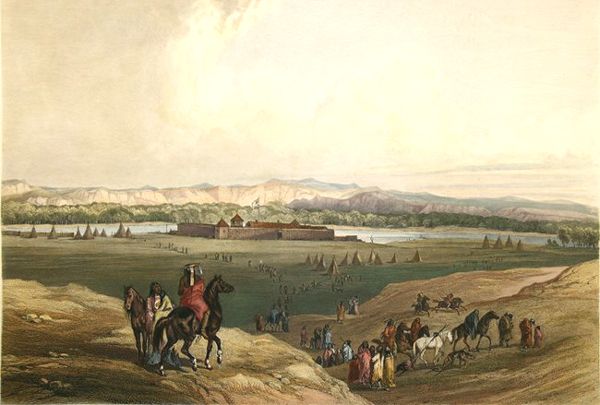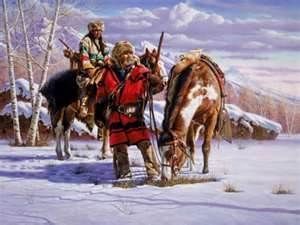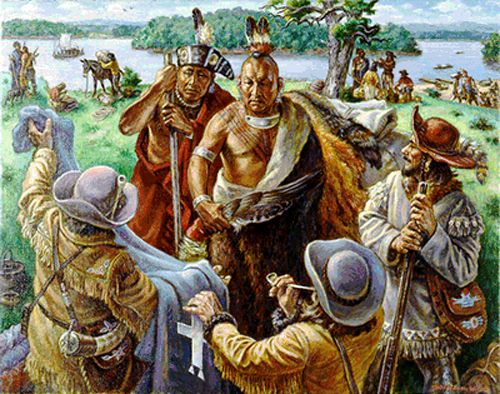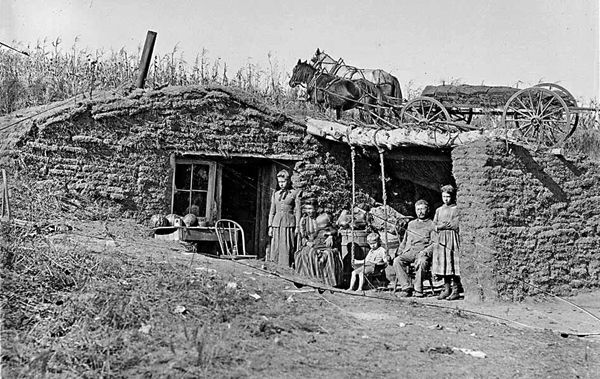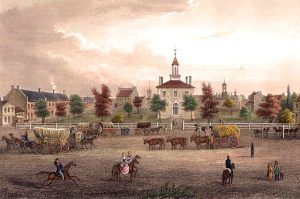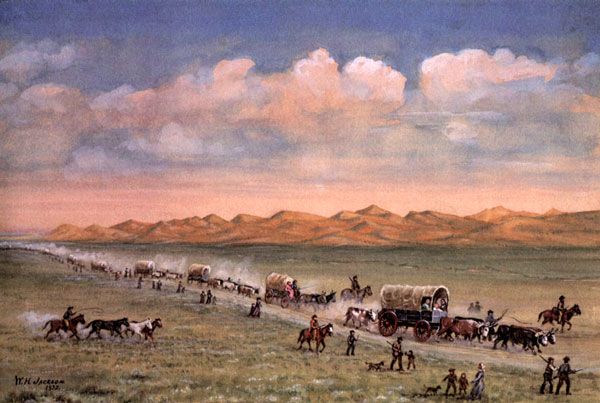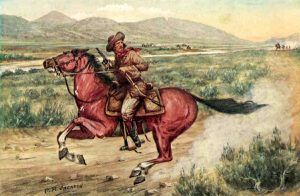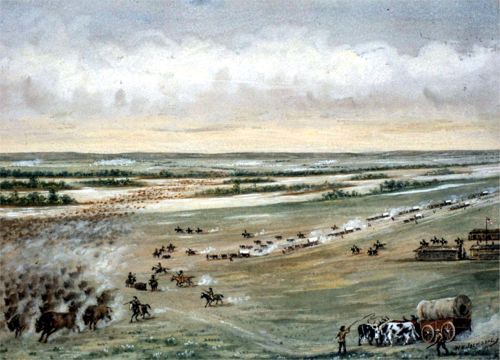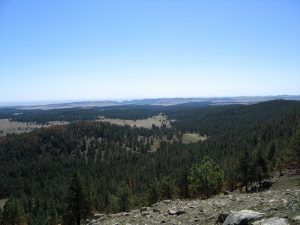Beginning of Settlement in the American West – Legends of America (original) (raw)
Fort Union on the Missouri River by Karl Bodmer.
By Randall Parrish in 1907
Trading-Posts Built on the Missouri River
Permanent occupancy of this country of the Great Plains can be dated from the early days of the fur traders. While individual traders and free trappers were probably first in the field and carried their small packs down the rivers to St. Louis, Missouri, where they sold them to Eastern dealers, yet close upon their heels came partnerships and organized companies. The latter soon discovered that it was far more profitable to maintain established posts, to which the surrounding Indians might easily travel and exchange their season’s catch of furs for other articles of value. Such posts were built all along the west side of the Missouri River and for some miles up those tributary streams, cleaving the prairies of Kansas, Nebraska, and the Dakotas. Differing somewhat in size and the importance of equipment, all these earlier fur-trading establishments had much in common.
A few, those which were largest and erected amid hostile tribes or as centers for the supply of minor posts, were well fortified, surrounded with strong palisades, heavily manned by organized fighting men, and, in one or two instances in the warlike Sioux country, even surmounted by small cannon. However, the great majority consisted only of a simple trading store, with a few necessary buildings where the employees lived. Isolated for years from all contact with civilization, and without even a visit to the East, surrounded by a savage and oftentimes hostile population, their environment the vast Plains, their business merely barter, the existence of these lonely men became a dull, colorless routine, relieved only by such adventures as arose from daily contact with wildlife.
Development into Settlements
Fur Trapper.
But, this was the beginning of permanent settlement, for each trading post required employees, the number varying with the importance of the post. There were the trader and his clerk, wood-cutters, and hay-makers, who were also boatmen upon occasion, probably a few white trappers under contract, with a worker or two in wood and iron. Sometimes, as at Fort Lisa, Nebraska, opposite Council Bluffs, Iowa, and some others of those larger posts up the river, women braved the wilderness to be with the men they loved.
Certain posts became favorite resting places for free trappers, while others had many paid hunters in their employ. Proper care was required for such demand building houses, usually of logs, sometimes of earth, or even stone, and the Indian trading house was gradually developed into a general store where white and red could find its necessities. The requirements of the frontier always included an abundance of ” red liquor,” and the hardy dispenser thereof was not long delayed in coming to the rescue of the thirsty. So, little by little, most of these earlier trading posts changed into ugly, straggling settlements, their inhabitants at first mere wanderers, the faces changing with each season; as one disappeared into the unknown, another came drifting out of it to fill the vacancy. Roustabouts from the riverboats, tired or dissatisfied voyageurs, hunters from off the Plains, adventurers, vagabonds, and the scum of the frontier came and went. Yet, always a few lingered on in solid content until out from the great East began to arrive those first daring settlers of a new country, with wives and children, horses and plows, seeking a permanent home where land was cheap and where manhood counted for more than dollars.
Settlements Become Towns
Osage Traders by Charles Banks Wilson, courtesy of the artist.
This was, in brief, the story of the beginning, the tale of a hundred towns now dotting the western banks of the Missouri River or looking down in peaceful content upon the waters of the Kansas River, the Platte, the Niobrara, and many streams between — the Indian trader, the wanderer, the settler; the gradual change from lonely post to prosperous village. The later advance westward was fairly rapid for the first 150 miles. For that distance, the prairies were inviting, the growth of grasses and timber along the bottoms gave abundant promise of other crops, the rainfall seemed sufficient, and the Indian tribes remained peaceful.
Everything in nature urged the settlers onward to possess this good land. Yet they came in no crowds, for there was still much vacant country in the East. Only a few, the more adventurous and those loving the wild frontier life, pressed across the wooded hills of Missouri or the rolling pastures of Iowa to make settlements on the untried prairies. They were bold hearts who first found passage over the yellow flood and established their homes in the heart of the wilderness.
Early Settlers in Kansas and Nebraska
These firstcomers clung close to the stream valleys and the productive bottomlands. Led by prejudices engendered in the experiences of the East, they shunned the open prairie, holding it as of little value. They built their log huts in the timber by the river’s edge or amid those small groves common to the country and led lives of privation, hardship, and occasional peril.
Yet this thin skirmish line was constantly advancing further into the unknown and gaining new recruits from the East. Travelers’ published letters, explorers’ reports, and private messages to friends all steadily increased the inflowing tide. Soldiers whose terms of service had familiarized them with the country settled there; hunters, charmed by the rare beauty of this prairie land, became permanent residents, and the trader was ever close at hand with his stock of goods.
Organization Into Territories
Nebraska Homestead.
There was, however, very little permanent white settlement in either Nebraska or Kansas until after 1854, at which date these Territories were legally organized. Previous to this, the entire region had been designated merely as the “Indian country,” and its population consisted of little more than wandering trappers and hunters, scattered fur traders with their few employees, and those men interested in the Santa Fe trade. Yet the rush across the border began as soon as these Territories were formally thrown open to settlement. The local census in 1855 credits Kansas with a population of 8,501, which increased in five years to 107,206. In Nebraska, the growth was less remarkable; its population in 1855 was 4,494, and in 1860, 28,441. In both cases, the settlements were almost totally confined to the river bottoms and within a comparatively short distance of the Missouri River.
Influence of the Santa Fe Trade and the Mormon Migration
Independence, Missouri Square, 1855.
The Santa Fe trade significantly influenced the early settlement of Kansas and the Mormon migration, together with the opening of the Oregon Trail on that of Nebraska. The more rapid development of the southern Territory can also be traced to the struggle against slavery, which brought ardent sympathizers with the North and the South to Kansas soil, respectively, in the fiercely raging controversy. While the main outfitting of the caravans bound for Santa Fe occurred at Independence, Missouri, the necessities of the trade early developed a considerable settlement at Council Grove, Kansas.
This point was nearly 150 miles west of the starting place. Being on the edge of hostile and perilous Indian country, it became utilized for refitting in final preparation for the more serious advance.
Here was a thickly wooded bottom, half a mile to a mile in width, of indefinite length, and affording a great variety of excellent timber. Settlers found their way here at a very early date, some among them being skilled workmen. Round Grove, 35 miles from Independence, was also a rendezvous of caravans, resulting in a small settlement. Where these first trails were compelled to cross considerable streams, enterprising ferrymen quickly established themselves, and in a few years, a store appeared with the rude beginnings of a village. Topeka, Kansas, was thus begun from Papin’s Ferry.
Squatters Along the Trails
Oregon Trail pioneers pass through the sand hills painted by William Henry Jackson.
The opening of the Oregon Trail left scattered squatters along its way beside the Vermilion, the Blue, and the Platte Rivers, but so far apart as to be scarcely noticeable. These men, except the operators of ferries, lived principally by hunting and became much like their red neighbors in customs and appearance. Not a few cooperated with the latter in raids upon the passing emigrant trains. The exodus of the Mormons along the Platte Valley likewise left a slight population in favorable locations along their route, but in neither case were those settlers’ propagators of civilization. They were the mere scum of the frontier, living from hand to mouth, little better than the vagrants of the Plains, with whom they associated on terms of a fraternity. In nearly every Indian village were to be met renegade white men.
Degraded Character of the Early Settlements
Pony Express Rider.
The establishment of stage lines, and later of the Pony Express, compelled the building of stations at certain distances apart in a line extending from the Missouri River to the mountains. These stations, usually mere shacks, sheltered the station keeper, the drivers or express riders, a few hostlers, and men employed in various capacities by the company. The result was commonly the growth of a small settlement, generally with its low groggery and a gambler or two to separate the boys from their hard-earned wages. Some of these stations on the Overland Trail, notably that of Julesburg, Colorado, where the Denver division began, grew into considerable importance, attracting a heterogeneous population of frontier characters and composing a veritable hell.
Drinking, carousing, and promiscuous shooting were the principal occupations both day and night, and very few women of respectability were to be found there. That mere ability as bar-room fighters did not necessarily mean the possession of true courage was more than once proven in the history of Julesburg, Colorado.
Fort Kearny, Nebraska.
On one occasion, when the town was harassed by Indians, an old soldier managed to gather together a hundred of these desperate frontiersmen to drive back the marauding warriors. They started forth full of whiskey and bloodthirsty threats and, by some miracle, were even brought within sight of the Indian encampment. But by that time, they were out of both whiskey and courage.
Their leader gave the word to charge and spurred forward. Hearing no sound of hoofs behind, he glanced back, only to discover his gallant band scurrying away in every direction. There being no other course possible, the disgusted soldier turned and followed them.
During the earlier years, before the Territorial Act, few Missourians crossed the border and took squatter’s possession of land in eastern Kansas, occasionally arriving in organized companies. Numerous churches of the east dispatched missionaries to this far frontier, but their efforts were principally directed at the Indian tribes close to the Missouri River. The Government established several garrisoned posts along that river, the most important being old Fort Kearny, on the present site of Nebraska City. Other posts, Forts Leavenworth, Scott, and Riley, were erected farther out in what was yet known as the “Great American Desert,” which was believed to be utterly useless from an agricultural standpoint.
Discovery of Gold in Colorado
Early Denver, Colorado, 1859.
In 1858, the discovery of gold in the Rocky Mountains led to some slight settlement on the western edge of the Plains bordering the foothills. While the miners flocked to the gulches of the great range, some there were who found profitable occupations in the cultivation of supplies for the camps along the valleys of the streams flowing eastward. These farmers were to be found at Pueblo on the Arkansas River, along the banks of Cherry Creek, and on the present site of Colorado City. At this time, the city of Denver began, with one William McGaa building the first stockade and William Larimer erecting the first house. This was a log cabin, 16 by 20 feet, having an earthen floor. It stood near the corner of what is now Larimer and Fifteenth Streets. There were, in 1858, five women in Denver. In the Spring of 1859, several farmers began operations in the rich Arkansas River bottoms.
Corn was worth five to 15¢ a pound, and a successful crop was as valuable as a gold mine. Uniting together, these farmers constructed an irrigating ditch from the Fontaine-qui-Bouille over their fields and planted corn.
When it had reached a good size, already waving temptingly in the wind and sun, a company of disgusted Missouri prospectors on their way back East made camp near Fontaine City and foraged their lean and hungry cattle on the green blades and juicy stalks. The farmers remonstrated, but the Missourians outnumbered them and only laughed. There followed a fight in which some of the Missourians were killed and several on both sides wounded. The victory, however, was with the farmers.
Developing Freighting in Colorado

Stagecoach with a guard sitting on top, protecting whatever wealth it might have been carrying.
This rapid populating of Colorado resulted in a continuous freight stream across the Plains. Still, outside of these narrow lines of communication, there was no settlement in all that wide expanse of level desolation. The freight trains of Russell, Majors & Waddell dragged their winding length along the Arkansas River, or Smoky Hill Trail, daily, bringing cargoes of goods stored at their depots and sold to retail merchants. Thousands of wagons stretched also in a continuous line along the valley of the Platte River, mail facilities were introduced, and, as early as 1859, stagecoaches were running on regular schedules to Leavenworth, Kansas. A branch of the Pony Express operated from Julesburg, Colorado.
Settlers Restrained by the Hostility of the Sioux
The Black Hills of South Dakota.
Farther north, in the Dakotas and Wyoming, few signs of permanent settlement were to be perceived so early. The continued and almost constant hostility of the various tribes of the Sioux Nation, together with the unattractive appearance of the country, conspired to restrain settlers. The fact that no great highway traversed the Plains of Dakota also made its advantages less known. The fur traders still held to their forts along the Missouri River and tributary streams, and some prospecting had been undertaken in the Black Hills with indifferent success. The first permanent settlement was made at Sioux Falls in 1856, and a year later, a few farmers came in along the valley of the Missouri River. Traveled over by thousands on their journey to Oregon or California, Wyoming remained a primitive wilderness, its sole signs of settlement a few fur-trading posts. Nothing served to halt the multitude, and while a few may have idled along the way, there was no permanent population worthy of notice.
This was the condition of the Great Plains when, in 1854, Kansas and Nebraska were made Territories and legally thrown open to settlement. Across the broad expanse stretched well-used trails, along which freighting wagons toiled westward to the mountains or emigrant trains crawled on their long journey to the Pacific.
The vast interior was yet scarcely known, touched here and there by solitary trappers, or scouted over by squads of hard-riding troopers, it yet remained an unexplored wilderness, the domain of wild animals and wild men. A slight fringe of early white settlements began to show along the eastern river courses; a little later, adventurous miners swarmed through the gulches of the Rockies, but all between stretched the lonely desolation which the geographers yet called the “Great American Desert.”
Compiled and edited by Kathy Alexander/Legends of America, updated May 2024.
About the Author: The Beginning of Settlement in the American West was written by Randall Parrish as a chapter of his book, The Great Plains: The Romance of Western American Exploration, Warfare, and Settlement, 1527-1870; published by A.C. McClurg & Co. in Chicago, 1907. Parrish also wrote several other books, including When Wilderness Was King, My Lady of the North, Historic Illinois, and others.
Also See:
Westward Expansion and Manifest Destiny
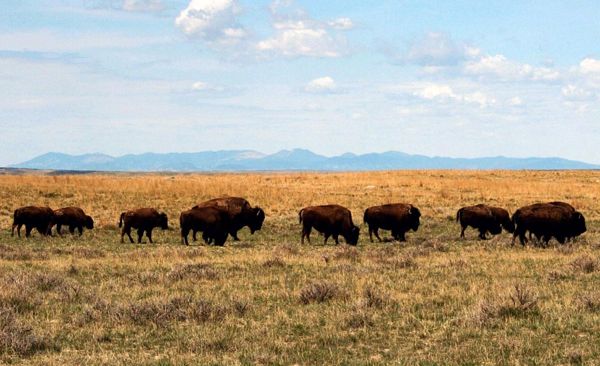
Buffalo on the Great Plains.
More Tales by Randall Parrish:
Adventures and Tragedies on the Overland Trail
Border Towns of the American West
Mushroom Towns of the American West
